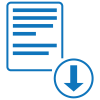Fillable Form Check Register
A check register is a record of transactions in a checking account.
Fill and sign Check Register online and download in PDF.
What is a Check Register?
A Check Register, also known as Checkbook Register, is an informal record that documents deposits to and withdrawals from an account. It keeps track of account balances for business and personal finances, crucial to staying on top of the financial well-being of an individual. As a financial document, individuals may also use it as an account register for savings and credit card accounts.
Using a check register is an advantageous way to keep all check records in one place. If you are an individual who uses several checks in different financial transactions, maintaining a check register is useful to eliminate several check records. While generally, it is only a single-page document, it provides a comprehensive record of all credits and debits made from a bank account.
A check register lets an individual stay updated with his or her financial well-being by keeping track of spending habits. By maintaining a record, an individual is obliged to look at where his or her money is going and how much is left. In addition, though it rarely happens, when a bank commits mistakes on their record, an account holder can identify errors and get them corrected. It is also beneficial to keep a self-maintained check register and compare it with bank records periodically even if an account holder trusts his or her bank. Other benefits of using a check register include catching identity theft, avoiding bounced checks, knowing how much you can afford to spend, knowing what you have paid off, and seeing spending trends.
Maintaining a check register requires an individual to update it every transaction so it constantly serves as a reliable source of financial information and activities. This means that in every transaction, updating the record should be done promptly to avoid any possible confusion. Anyone can use a check register to keep a record of daily financial transactions. As one keeps a record of his or her daily expenditure, a check register allows a person to keep track of his or her available balance at any time.
How to fill out a Check Register?
Get a copy of Check Register template in PDF format.
A check register template is a reliable document that you can use to track your check deposits and payments. It can help you maintain a record of all financial transactions to stay on top of your finances, allowing you to check the available balance on your account.
Filling out a check register template requires diligence, as you need to update it every transaction so it serves as a reliable source of your financial information and activity.
Using PDFRun’s Check Register Template can help you track your finances in minutes. Follow the guide below to fill out the template accurately.
Provide your name, the beginning balance in your account, your checkbook period, and your checkbook balance.
A check register template contains a table that asks for the details of a financial transaction. In every transaction, provide the following:
- Check Number — Write the check number and make sure that you are not missing any check.
- Date — Provide the exact date when the transaction happened.
- Transaction Details — You may write the name of the person to whom the check was given. If you are dealing with a business, provide the business name.
- C — Under the column, mark the row that corresponds to a transaction when the check for that activity is already cleared.
- Debit — Write the debit amount.
- Credit — Write the credit amount.
- Balance — Compute the balance for each transaction.
Start filling out a Check Register sample and export in PDF.
Frequently Asked Questions About a Check Register
What transactions should you put in the check register?
A check register should include transactions that have cleared your bank account. This means that the money has been transferred from the bank to your account and is no longer pending. The balance shown in your check register should match the balance shown on your bank statement.
For each transaction, it must list the date, the amount of the transaction, and what it was for. It must record all debits, credits, and deposits to your bank account.
It is important to keep accurate records in your check register so that you can track your spending and budget accordingly. You should also reconcile your check register with your bank statement on a regular basis, to ensure that your check register is accurate.
A check register can help you to track your spending and prepare for the end of the year tax time.
What three things should you document in the checkbook register?
The three most important things you should document in the checkbook register are:
- The date
- The amount
- What the payment was for
These things will help you keep track of your spending and make sure all your payments are accounted for.
If you're using a checkbook register to budget your money, it's also important to note what category each expense falls into. This can help you stay on track with your spending and make sure you're not overspending in any one area.
Some people also like to track their net worth in their checkbook register. This can give you a snapshot of your overall financial health and help you see where you need to make changes.
No matter what information you choose to track in your checkbook register, the most important thing you can do to make sure your records are accurate is to balance your checkbook every month.
The best way to keep track of whether or not you're in the black (meaning there's enough money in your account) is to reconcile your bank statement and your register every month and make sure the numbers match exactly. If they don't, you'll know there's a mistake somewhere and can figure out where it is.
This is also the best way to make sure all your accounts are up to date with transactions. You never want to have an empty register because you didn't record something correctly. And if transactions aren't documented in your checkbook, they won't show up on your bank statement, which can lead to all sorts of financial headaches.
By keeping track of your spending and balancing your checkbook every month, you'll be able to stay on top of your finances and avoid any nasty surprises down the road.
What information is recorded on the check register?
The following items should be recorded in the check register:
- Date — is the date on which the transaction takes place.
- Check number — refers to a unique number that can be assigned to each check written for a specific instance of a transaction. For example, if a person writes ten checks in one day, they will have ten different check numbers assigned to them.
- Description of the transaction — is the specific information about what was bought with the check.
- Debit — is the amount of money that was taken out.
- Credit — is the amount of money that was deposited into an account.
- Balance — means how much money you have in your account after this transaction took place.
How do you use a check register?
To use a check register, simply write the date, the check number, and the amount of a check in the appropriate columns. Make sure that all the information you will add to a check register is accurate to avoid any confusion.
If you have more than one checking account, it might be helpful to create a column for each account to help you keep track of the balances. You can also use a check register to record automatic payments or transfers between accounts.
Some people like to color-code their check registers according to the month in which the transactions occurred. This can help you keep track of your spending throughout the year.
No matter how you choose to use your check register, it is a valuable tool for tracking your financial activity. By keeping accurate records, you can ensure that your finances stay organized and in control.
You can also use a check register to keep track of deposits and withdrawals. This will help you to stay aware of your account balance and make sure that you're not spending more money than you have in your account.
How often should you check your check register?
While some check their check register once a month, it is ideal to visit and review your check register once a week to make sure everything is as it should be. Doing so ensures that everything is accounted for and nothing falls through the cracks.
If you happen to notice any discrepancies, take action immediately. This could include contacting your bank if there are any unauthorized transactions or reconciling your checkbook ledger with your bank statement.
It’s also important to keep your check register up-to-date. Make sure to note the date and amount of each deposit and withdrawal, as well as the purpose of the transaction. This information will come in handy when you’re ready to file your taxes.
What are the benefits of using a check register?
The following are the benefits of using a check register:
- Tracking expenses. A check register can be a useful tool for tracking daily expenditures and balancing a checkbook. By recording the date, amount, and purpose of each expense, individuals can more easily identify spending patterns and make adjustments as needed. In addition, check registers can be used to keep track of credit card statements. It is often easy to forget how much has been spent using a particular card, but this information can be recorded in the register so that it is readily available when needed.
- Reminders. A check register can serve as a reminder of when bills are due, what checks have been written previously, and when accounts will need to be reconciled.
- Organization. A well-organized check register can make balancing a checkbook a breeze. By recording all transactions in one place, individuals can quickly and easily identify discrepancies, if any exist.
- Reimbursement requests. When an individual pays for an expense on behalf of another person or business, he or she can keep a record of the expenditure in the check register. This information can then be used to create reimbursement requests.
- Account balances. In addition to keeping track of spending, a check register can also provide an account balance for each account listed. This information can be helpful when budgeting and planning for future expenses.
As you can see, there are a number of benefits to using a check register. If you are not currently using one, it may be time to consider doing so. A well-maintained check register can help you stay on top of your finances and make informed decisions about your spending.
How do you reconcile a check register?
To reconcile a check register, you will need to find the difference between the ending balance and the beginning balance. This difference is what is known as the reconciled balance. If this number matches the bank statement, your reconciliation is complete.
If there are discrepancies, you will need to investigate where the differences came from. This may involve contacting the bank or looking through canceled checks and deposit slips.
If you find that there is a difference, the beginning balance is the reconciled balance on your bank statement, and your ending balance (from your check register) will be added or subtracted to make up for this difference. The transaction will then need to be changed in order to correct it. It's important to note here that if your ending balance does not reconcile, there is a problem with the transactions recorded in your check register.
One of the most important parts of reconciling a bank account is identifying all deposits and checks that have cleared since your last reconciliation. The easiest way to do this is by using deposit slips or online banking records if these items are available.
Once you have a complete record of all cleared transactions, you can begin reconciling your account. First, find the beginning balance on your bank statement. This is the amount that was in your account at the beginning of the month. Next, add up all of the deposits that have cleared since your last reconciliation. Then, subtract all of the checks and withdrawals that have cleared. The resulting number is your ending balance on the bank statement. If this number matches the reconciled balance in your check register, your reconciliation is complete.
What is the purpose of a checkbook register?
A checkbook register serves several purposes:
- It assists you in balancing your checkbook by providing a record of the transactions that took place.
- You're able to see a list of what checks, debits, and deposits cleared through your bank account for a particular month. With this information, you can verify that all transactions have been processed. You'll be able to quickly notice any incorrect or unauthorized transactions.
- You'll be able to find the exact date of any transaction at a glance.
- You can keep track of your spending by reviewing the checkbook register each month. You should also compare it to your credit card statement and bank statements that were sent to you during that timeframe. This will help you create a budget and make a spending plan.
How long should I keep my check registers?
How long you keep your check registers depends on your need for them. In general, you can keep check registers for at least 12 months. It's advisable to keep them longer, just in case you need to refer back to them for tax purposes. Keep them longer so in cases where issues would arise, you have records of your financial transactions.
Also, another reason why it is good to keep check registers is that it can help you determine if your spending makes sense. This can be helpful when you're looking for areas of improvement. If it seems like you never have money left by end of the month, this is something that needs investigation. You may need to adjust your spending habit.
When you have a check register, it can also help your family members determine what happened to missing money if anything were to happen to you. That way, at least there is some record of the transactions that occurred while you were alive. You don't want your heirs going through all sorts of hassle just because there's no check register or
Some people want to keep their check registers forever and that's fine because you never know when you may need to refer back to them. It is a good idea to include any information about the check: what it was for (if there's no obvious reason), the date it cleared, and other relevant information.
When should you update your check register?
It is recommended to update your check register once a week to ensure that all your financial transactions are accounted for. This will help you stay organized and on top of your finances.
If you have any questions about how to use a check register, or about any of the transactions listed, be sure to consult your financial institution or accountant. They can help you understand and interpret your financial information, and help you make better financial decisions.
What are the three types of check register?
There are three types of check registers you can choose from:
- A traditional paper check register is the most common. All transactions are recorded on a sheet of paper where you record the date, payee's name, category, and amount for each transaction.
- A computerized check register is what all modern check registers are. It is also known as an e-check register. This type of check register is basically an online form that records the transactions on your computer or mobile devices. All you have to do is create a record, define each category, set up reminders, and upload photos for purchases receipts. You can easily access this data at any time as long as you have an internet connection.
- A hybrid check register is another term for a paper record where you can also maintain your records using an electronic device such as computers and smartphones. This particular type of check register allows the user to switch from paper mode to computerized mode depending on what he or she prefers. The advantage of using a hybrid check register is that you can always have a physical backup of your data just in case something happens to your electronic device.
No matter what type of check register you choose, the main purpose is to have a documented history of all your transactions. This will help you stay on top of your finances, be able to review your spending patterns, and make adjustments when needed.
Why is it important to record all transactions in the check register?
It is important to record all your transactions in a check register to ensure the accuracy of your expenses. This will help you stay on budget and keep track of your bank balance. Moreover, checking your bank balance regularly will help you avoid overdrafts, bounced checks, or other banking fees.
What happens if you do not balance your checkbook?
The consequences of not balancing your checkbook are the following:
- You will not know the total of your assets and liabilities.
- You will not know your current balance.
- Your checks may bounce because you do not have enough money in the bank to pay for them when they come due, or they could be rejected by the account holder if there is insufficient money in your account
Other consequences include social, financial, emotional, physical, and mental aspects of one's well-being. First of all, not balancing your checkbook can have dire consequences on your financial stability. Without knowing the total of your assets and liabilities, you will be unable to track your progress, or lack thereof, in reducing your debt or increasing your savings. You may also end up bouncing checks and accruing overdraft fees, which will only add to your financial drain. Furthermore, if your checks are rejected by the account holder for insufficient funds or your bank account is overdrawn, you could end up with an overdraft fee, a returned check fee, and several late fees on top of any money owed to the store where you wrote a bad check. It can also negatively affect other areas in your life because many times you have to give your account number out when purchasing something. If a criminal gets their hands on your account information they could wreak havoc on your financial situation, by running up a large amount of debt in your name and draining all of the money from your accounts. Not only that, but if someone steals your checkbook or credit/debit card they could do even more damage to your finances. Also, if you give your account number out over the phone or on the internet, someone could hack into your accounts and access all of your information, including pin numbers and routing numbers. This would allow them free reign of your bank accounts until they are caught.
A second consequence of not balancing one's checkbook is possible social consequences. If you give your bank account number to someone and they can access all of your information and drain your money, then it could cause serious problems within that relationship. For example, what if the person you gave your debit card numbers to were a significant other? They now have full access to not only run-up debt in your name, but also to withdraw all of the funds from your account, leaving you stranded and with no money to pay your bills. This could lead to a large argument or even a breakup.
Another potential social consequence of not balancing your checkbook is that you may be viewed as being irresponsible by others. This could cause people to be less likely to want to do business with you, or even loan you money in the future.
In addition, there are also emotional and mental consequences of not balancing your checkbook. For example, if you are constantly stressed out because you can't seem to get your finances in order, this could lead to depression or anxiety. Additionally, if you are dealing with large amounts of debt it can be very emotionally and mentally draining. This is because debt can often feel like a weight that is constantly bearing down on you. It can lead to feelings of failure and inadequacy. It can also cause you to feel overwhelmed, which in turn may make it difficult for you to focus on other areas in your life such as work or school.
Lastly, there are physical consequences associated with not balancing one's checkbook. For example, anxiety and depression can often lead to insomnia or poor eating habits, both of which can lead to weight gain. Additionally, if you are constantly stressed out it can take a toll on your body, leading to things like high blood pressure and heart disease.
In conclusion, there are many potential consequences of not balancing one's checkbook, both financial and non-financial. It is important to regularly balance one's checkbook so that one can stay on top of their money and avoid the consequences associated with not doing so.
Do banks give out check registers?
Some banks give out a check register. The best and easiest way to know whether your bank gives a check register or not is to simply ask. You can also ask about other features that the bank offers, such as online banking or automatic bill payments.
If your bank doesn't offer a check register, you can always purchase or create one.
Create a Check Register document, e-sign, and download as PDF.
Related Articles:
Keywords: check register check register template check register form fillable check register printable check register check register sample check register pdf
















